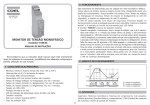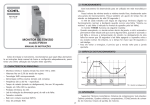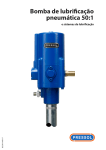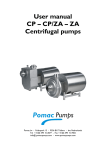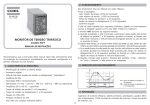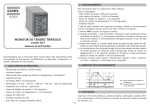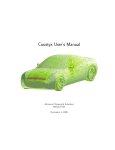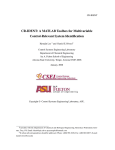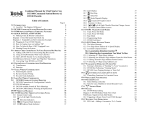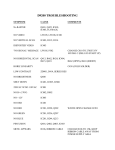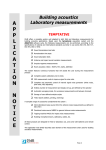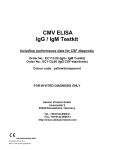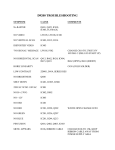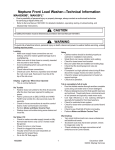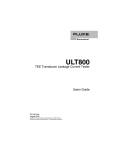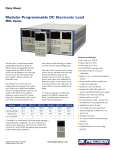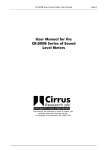Download PC-PACK ANALYZERS - All
Transcript
SPECIFICATIONS S P E C I F I C AT I O N S Number of input channels Frequency band Dynamic Throughput rate Digital trigger/tach Generators Connectors Dimensions Weight Power Battery OR24 2 or 4 20 kHz 90 dB 4 x 20 kHz Up to 20 V, up to 300 kHz 2 outputs, 3 Vrms - 600 1 BNC 250 x 170 x 45 mm 9.8 x 6.7 x 1.8 in 2 kg - 4.4 lbs 100-240 VAC External, 90 min (option) OR25 - Model 100 2 or 4 20 kHz 90 dB 4 x 20 kHz Up to 20 V, up to 300 kHz 2 outputs, 3 Vrms - 600 1 BNC 415 x 270 x 55 mm 16.3 x 10.6 x 2.2 in 3.5 kg - 8 lbs 100-240 VAC , 10-30 VDC Internal, 90 min O R25 - M o d e l 30 0 2, 4, 8 or 16 all upgradable 20 kHz 90 dB 8 x 20 kHz Up to 20 V, up to 300 kHz 2 outputs, 3 Vrms - 600 1 BNC pad + cable 415 x 270 x 90 mm 16.3 x 10.6 x 3.5 in 5 kg - 11 lbs 100-240 VAC , 10-30 VDC Internal, 60 min OR24 OR25 OR24 and OR25 PC-Pack II are delivered with traceable calibration report, software on CD, key disk for software options, installation and user manual, carrying case and 12 months warranty. In addition, OR25 PC-Pack is delivered with cigarette lighter adapter. COM M O N SPECIFIC AT IONS FOR ALL MODELS: FFT Real-time band Frequency range Frequency resolution Zoom Trigger Valid-reject Display trace 1 mV to 31,6 Vrms, autorange, accelerometer and microphone constant current supply (ICP™), AC/DC/Float 100 V 90 dB 200 dB/octave single-double integration / differentiation, time or frequency domain A, B, C, programmable low-pass, high-pass, band-pass, stop-band 0 to 20 V, 300 kHz (over sampling) 2 outputs, 3 Vrms, 600 1 DC to 20 kHz autosensing 100-240 VAC, OR25 only: 10-28 VDC, built-in battery charger 100-240 VAC and 10-30 VDC inputs, cigarette lighter cable, same dimensions as OR24 IEC 68-2-6 operating: 5-100 Hz, 5 mm, 2 g (5-500 Hz, 5 mm, 1 g) IEC 68-2-7 10 g (11 ms, 1/2 sine), 70 g (3 ms, 1/2 sine) IEC 68-2-7 20 g (11 ms, 1/2 sine), 100 g (3 ms, 1/2 sine) operating 0°C [32°F] to 45°C [113°F], storage -25°C [-13°F] to 70°C [158°F] complies with EMC Directive and Low Voltage Directive Display type Average Overlap Weighting Generator 1 Generator 2 Export 4 ch. x 20 kHz, 8 ch. x 10 kHz, 16 ch. x 5 kHz continuous, 20 kHz in multiblocks mode 0.5 Hz to 20 kHz, 1, 2, 4, 5, 8, 10, 20, 25 progression 100 to 3200 lines 1 to 128 free run, level, external, manual RPM, delta RPM, delta time, delta level normal, manual, automatic on overload input signal, trigger, spectrum, cross spectrum, FRF H1 & H2 (magnitude-phase-real-imaginary), coherence, envelop, spectrum of envelop, orbit, auto & cross correlation, DC level 2D, single or multitrace, overlay of live and saved traces, waterfall with section in time, frequency or order, XY linear, exp, peak hold, ref. peak hold, in time or frequency domain 0%, 25%, 50%, 75%, 90%, max, retrigger Hanning, Hamming, Flat-top, Uniform, Kaiser-Bessel, Exponential, (adjustable force and response), User defined Sine, Multisine, Swept Sine, Random, Chirp, Burst, User (*.bin or *.txt file) Sine with same Gen1-frequency and programmable phase and amplitude, non correlated Random Noise Bin, Text, UFF (58), Matlab™ RECO R D ER Continuous rate Transient rate Trigger Length Export Display 8 ch. x 20 kHz, 16 ch. x 10 kHz on the disk of the PC 16 ch. x 20 kHz during 5 seconds trigger signal, timer, manual limited by the size of the disk, 2 bytes/ sample, 100 kB per channel per second (0 - 20 kHz band) WAV, multichannel, 51.2 kHz sampling frequency, SDF input signal, frequency spectrum, signal file OFF -LI N E FFT Play back Output filters FFT analysis 1 or 2 channels of the signal file to generator outputs, complete file, section, single or repeat A, B, C weighting, programmable low-pass, high-pass, band-pass, band-reject on complete file or section between 2 cursors, same parameters and display as real-time FFT. continuous or block-by-block analysis on 1 or several channels For options and NVSolutions®, please ask for the relative data sheets or visit our web site. OROS, Inc. OROS S.A. 502 Shaw Road B-101 23, chemin des Prés Dulles, VA 20166-9435 ZIRST 4403 USA F-38944 Meylan cedex Phone: +1.888.200.OROS Phone: +33 476 90 62 36 Fax: +1.703.478.3205 Fax: +33 476 90 51 37 E-Mail: [email protected] E-Mail: [email protected] Matlab is a trademark of Mathworks Co. Windows 98, 2000, NT4, ME and XP, Word and Excel are trademarks of Microsoft Corp. ICP is a trademark of PCB Piezotronics Inc. NV Solutions is a trademark of OROS SA OROS SA is ISO 9001 certified www.oros-signal.com C002-092-1 PC-PACK ANALYZERS Specifications not biding - design: Genco Oil - F38800 / photos: Nocomment! - Genco Oil Input voltage range Overload Protection Dynamic range Antialiasing filters Input conditioning Input filters External trigger-RPM Generator Frequency band Power supply OR24 battery option Vibrations Shocks operating Shocks storage Temperature CE marked www.oros-signal.com m er … am ra c ce th The compact multichannel analyzers for sound & vibration measurements e c t in p u t f o O R 2 4 & O R 2 5 P C- PA C K I I d ir OR24 & OR25 PC-Pack II Big on performance, small in size ler ome te r s, i m The OR24 and OR25 PC-Pack II combine the power and flexibility of a laptop PC with the precision of a dedicated instrument. They feature all functions of a sophisticated dynamic signal analyzer in a rugged package to be connected to a laptop PC for true, go-anywhere portability. The PC-Pack II is available in 3 models: - OR24: 2 or 4 channels - 2 kg (4.4 lbs) - OR25 PCP102 and PCP104: 2 and 4 channels - 3.5 kg (8 lbs) - OR25 PCP 302, PCP304, PCP308 and PCP316: 2, 4, 8 and 16 channels - 5 kg (11 lbs) OR24 and OR25 PC-Pack II are designed for mobile applications and on-the-move engineers. The aluminum housing and corner rubber pads protect it from shocks. They comply with standard shock and vibration tests for industrial use. The internal temperature is controlled by a quiet fan, which can even be switched off during sensitive acoustic measurements. All calculations are performed in real-time in the analyzer, ensuring real-time rates as high as 20 kHz for both FFT , Octave or Order analysis. Measurements are thus independent of the performance of the PC. The PC-Pack II can be installed on any PC. The signal recorder mode can continuously record the time domain signals from 8 channels or more (depending on the PC) up to 51.2 kHz (gap-free) sampling rate. ic Light and robust The OR24 and OR25 PC-Pack II offer high measurement quality: 0.05 dB gain matching, 0.1° phase matching, guaranteed by self-calibration circuitry. The high 90 dB dynamic range and extremely low noise level comply with the most demanding measurements. .. . m These models use the same software range and the same technology: up to 16 channels of real-time FFT, Octave and Order analysis, a multichannel signal recorder, and all the software facilities for post-analysis and report editing. Communication between the PC and the analyzer is made via an interface designed for industrial environments. Speed and precision ro ph one s High technology and ease of use rem ot The purpose of PC-Pack II is to make your measurements easier. Integrated power supply, integrated as well as external battery, cigarette lighter adapters, BNC connectors, convenient carrying case, all these features make it easy to carry and operate anywhere. The software runs under any version of Windows™: W98, W2000, WNT4, WME or WXP. As standard, analyzers are delivered with a PC Card for notebooks. For use with a desktop PC, a PCI interface is available in option. The analyzers support the most common data formats for easy communication with other systems. e co ntr ol t he l a pt o p The OROS NVSolutions® range offers complementary packages for specific analyses. st ra p p ed w it h PC ca r d in ter face pa c Standard software package Standard software package FFT ANALYSIS FEATURES OR24 and OR25 PC-Pack II come with a complete set of software modules for FFT analysis, compiled in 2 main programs: - OR763: Real-time FFT and order analysis - OR773: Recorder and off-line FFT and order analysis • Pr oject man agemen t: it organizes data into a project-subproject-measurement structure: configuration, settings, calibration data, transducer database, time domain data, frequency domain data, ... Real- time FFT - OR763 Off -Line FFT - OR773 • Guided men u s: These two programs run in the same environment, totally integrating all the peripheral features: project and configuration management, transducer management, measurement saving, importing and exporting, report editing. • the Next/Previous key is an easy way to explore all the set-up menus in a recommended order. With some practice, you will invoke directly any menu. Displa y capabilities: up to 32 trace windows, for time domain signal, spectrum, cross spectrum, FRF, envelope, zoom spectrum, coherence or auto and cross correlation... The overlay capability lets display several traces in the same window: then you can compare signals from different transducers or different saved files. • Displa y tools: 2D, 3D-waterfall, 3D-color spectrogram, orbit, labelling, lin. and log. scale in both axes, dB, ESD, PSD, simple/double integration/differentiation, graphic zoom, autoscale, cursor, full or selected frequency band RMS indicator, units, 20 kHz band overload indicators... • Cur sor s an d marker s: manual, harmonic, peak, side band, band power, octave bands. OR763 performs the FFT in real-time on the data from the analog input channels. OR24 and OR25 offer a computation power capable of processing the flow of data continuously. It supports real-time FFT on 4 channels at 20 kHz , with overlap, averaging, frequency resolution up to 3200 lines and various pre-processing functions like filtering or A-weighting. The continuous FFT rate is 10 kHz on 8 channels and 5 kHz on 16 channels. This rate can be extended to 20 kHz on 16 channels using multi-block analysis, and the internal memory. The real-time FFT mode displays the selected traces live: time domain like an oscilloscope, and frequency domain functions, in 2D or 3D plots. Some additional information is displayed: RMS value and overload indicators. The WAV signal file stored with the recorder is loaded in the offline mode for processing and analysis. You can then analyze the file or a section of it with the same capabilities as in the real-time mode. It is possible to zoom the signal file, and to move block by block in the file or continuously. In addition, the off-line mode offers a playback function: 1 or 2 channels of the recorded signal can be selected and played on the generator outputs, directly or filtered: low pass, high pass, band pass and band reject with programmable cut-off frequency. • Input fr on t -en d: settings of the hardware analog channels (input voltage range, AC/DC/FLOAT coupling, ICP™ source). • Input pr e-pr ocess: Recor der - OR773 Advanced Or der Analysis - OR763, OR773 some signal processing can be applied on the signal in the time or frequency domain, like digital filters (low pass, high pass, band pass, band reject), A, B, C or custom weighting, time or frequency domain integration, RMS or peak detectors. • Transdu cer man agemen t: transducer database, units database, transducer calibration (with calibrator or comparison). • Triggers: selected from any of the analog inputs or on the external trigger/RPM input. In addition to this, delta RPM, delta Time, delta Level, or Manual triggering are provided. • Level mon itorin g: this capability computes in real-time the RMS, Min, Max, filtered DC and traces them against RPM or Time. • Generators: 2 generators are available to generate various waveforms: sine, swept sine, random noise, burst chirp, multisine, and also any user defined waveform (with phase control and non correlated signals). • R PM: 1 or 2 tach. signals can be connected to any of the analog inputs or to the external trigger/RPM input. Some pre-processing features are provided for cleaning the tach signal if necessary. • Ex p or t: AE2 (OROS binary), TXT, bitmap and metafile to Word™, UFF to any analysis software package, MAT to Matlab™, SDF. • R ep or t: several modes of print out are offered. You can choose to print directly what you have on your display, define a template and print your data in this template. This mode makes your PC a multichannel signal recorder, like a DAT. You can acquire and continuously store 1 to 8 channels within 20 kHz bandwidth (51.2 kHz sampling) , and 16 channels within 10 kHz without any gap in the signal. The only limit in size is the capacity of your disk. For instance, a capacity of 1 GB can store 8 channels within 20 kHz band during more than 20 minutes continuously. During recording, time domain as well as frequency domain signals can be displayed for monitoring. You can do several records individually triggered by a time period or a trigger signal. The generators can be active during the recording if you want to excite a structure and record the responses. The data is recorded in a WAV format which support more than 2 channels, and the sampling frequency of 51.2 kHz. This WAV file can be processed in most multimedia packages or playback with a multimedia board supporting this sampling frequency. A WAV signal file can be post analyzed in FFT mode as well as in 1/n octave mode or order tracking mode (as long as a tach signal has been recorded). For vibration analysis on rotating machinery during a run-up or coast-down, it is interesting to display the vibration related to the RPM speed, the order plot. The order n is the vibration related to the nth harmonic of the rotating speed, and gives a representation of vibration coming from phenomena occurring n times in a rev of the machine. The Real-time FFT software and the Off-line FFT offer this feature: the signal is acquired according to the measured RPM speed and the delta RPM selected for the triggering. A waterfall plot is then displayed, and the order trace can be extracted from this waterfall. Note: the meaning of Real- time FFT The Fast Fourier Transform gives a direct representation of the signal in the frequency domain. This technique computes frequency spectrum and derived results like FRF from time domain data acquired by blocks. Real-time can have two meanings: one, quite obvious, is that you can see the frequency spectrum in live mode, continuously. This is equivalent to an oscilloscope in the frequency domain. The second meaning, which is the real meaning, is that the computation takes into account all the time domain data to compute the frequency spectrum. A consequence is that the computation rate has to be faster than the acquisition rate. This is a challenge for FFT analyzers, but a necessary condition to have an exact representation of the signal spectrum. Any loss of time domain data results in an error in the frequency spectrum. The real-time band is then a critical parameter if you want precise measurements. OPTIONS OPTIONS Ad vanc e d Di agnosti cs O r d e r Anal ysi s - OR79 3 6 This option gathers some tools dedicated to rotating machinery: Cepstrum, Kurtosis, envelope listening, Bode plot and the Constant Band Tracking (CBT). CBT is a technique used to track orders. It is an option of the FFT mode, and displays the energy in a selected frequency band around one selected order, against RPM or Time. CBT operates like a bank of tracking filters. It is possible to display up to 8 orders per channel, with an individually selected frequency band. Cepstrum and the other tools mentioned above are precious for vibration diagnostics, to isolate phenomena in a rich signal, in order to identify the source of the vibration (bearings, gears, misalignment, ...) This mode runs in real-time and in off-line modes. F FT b as e d 1 /3 Octave - OR 7932 Advanced Or der An alysis - OR7931 Time resampled order analysis is a key feature for in-depth investigation of engines, transmissions, turbines or any rotating machine. This technique directly computes and displays the vibration spectra in harmonics of the shaft speed, called orders. The result is much easier to analyze than a spectrum in frequency, since most of the vibration sources are related to the rotation of the machine. The OR7931 is based on a digital resampling technique, eliminating the various problems associated to analog techniques and offers precision, stability, and tracking capability for very rapid accelerating shafts. A runup from 1000 to 6000 RPM in a few seconds can be perfectly analyzed with high precision. For slower run-ups, the analyzer can average the data during the run-up to offer a higher precision. The display capabilities are: spectra in order, traces of selected orders against RPM or Time, waterfall display against RPM or Time, RPM profile. It is possible to track up to 8 orders per channel + overall, and to display them in one or several windows. A window edit function allows to overlay order traces from various sources: orders, channels directly or superimposed with saved data. For transmission analysis, 2 tach. channels are typically supported. This option can be used in real-time mode and in off-line mode. NVSolutions O R O S N V S o l u t i o n s® OR24 and OR25 PC-Pack II offer very flexible and advanced analysis tools for various purposes. In addition to these analyzers, OROS proposes a range of complementary solutions, developed by OROS or in cooperation with OROS. A total compatibility and suitability is then guaranteed. OROS - Repor ter This module is exceptionally easy and efficient for data browsing, calculation, and report edition. Active documents make reports easier and much more attractive. Reporter OROS - ODS Complementary package to OROS-Reporter, it displays the deflection shapes of a structure in operation. This is a precious tool for development or troubleshooting. OROS-ODS includes a geometry editor, and wizards for easy operation. Some additional translators are included for data exchange with other analyzers as well as software packages. Color sp ectr ogram - OR7934 ODS OROS - Modal OROS - Modal is a complete package for modal analysis and modal parameter determination. It supports SDOF as well as MDOF. It includes OROS- ODS, a modal shape organizer and efficient wizards. This module computes and displays spectra of a signal in 1/1 octave or 1/3 octave. It is based on a technique using the FFT simultaneously in 3 frequency bands in real-time, and synthesizing the 1/3 octave spectrum conforming to the IEC225 standard. The OR7932 is a complementary tool to the FFT analyzer. It can simultaneously display narrow band FFT and 1/1 or 1/3 octave spectra including phase. This option runs in real-time and in off-line modes. Filte r s b ased 1 /n Octav e OR7933 This option supports the FFT mode and the Advanced Order Analysis mode, and adds a time frequency color display capability. This display is very efficient for following up the results at a glance. The user can quickly locate the most critical points in the map, and then zoom and edit. Functions are offered to get more details at these points. The color spectrogram displays the main color map and 3 traces which are 3 sections of the color map. The real-time color map traces the history of the spectrum in frequency or order domain, against the RPM or the time. The sections are related to a selected RPM, a selected frequency, and a selected order. Moving the cursor on the color map continuously updates traces, and enables you to quickly find part of the map. An edit function allows you to set markers on the display . This mode runs in real-time and in off-line modes. Modal OROS - S ou n d I nte nsity This package conforms with ISO9614, parts I and II. It performs noise emission distribution analysis as well as sound power determination. It controls directly the analyzer for easy acquisition, and supports several types of probes with remote control. The 3D color mapping is particularly efficient and readable. Sound intensity For many acoustics measurements, an analysis of the signal based on filter bank technique is required. The OR7933 performs this using digital filters conforming IEC1260 and IEC 225. This module constitutes a complete 1/n octave analyzer: 1/1, 1/3, 1/12 and 1/24 octave. - A, B, C, weighting - LIN, EXP, LEQ, Fast, Slow, Impulse - Signal generator - Waterfall display - RPM triggering - Octave tracking This option runs in real-time and in off-line modes. OROS - Balan cing Spectral weigh t filter s - OR7937 This option enables the selection of specific filters on any input signal, in real-time or off-line mode. These filters are often required for evaluation of comfort in vehicles. The available set is : A, D, 1/A, A*D, 1/A*D, A*D[200-5000Hz], ISO2631 (Wc, Wd and Wk), BSI6841 (Wb, Wc, Wd, We, Wf ), BSI6842 (Wh). The spectral weight filters can be used in the FFT and 1/n Octave modes. Supporting 1 or 2 planes, OROS- Balancing uses a special technique usable even without stable speed. The graphic interface guides the user for placing the trial and the correction masses. Placing mass as well as removing material is possible. A mass can be split when some position cannot support the correction mass (blades). Balancing




